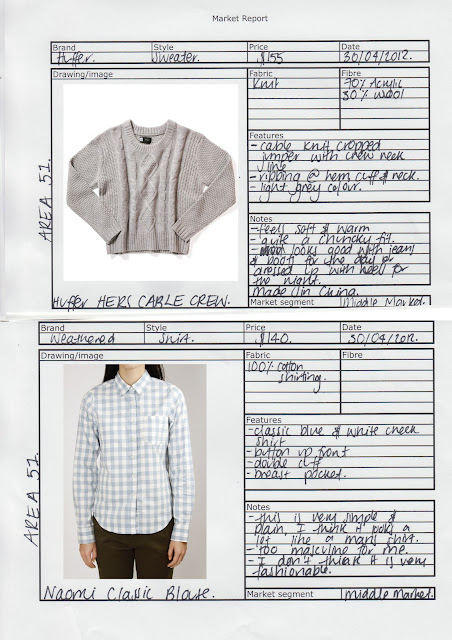Market Research
Here I have compared sweaters from two different High End Stores - Superette and Good as Gold. Both are a wool blend - it is nice to see some natural fibres in the mix rather than just synthetic - and feature a mixture of different knits. The Alice McCall sweater - to me - is more girlier than the Shakuhachi one and can be dressed up to go out more. The Shakuhachi sweater has a slightly more 'grunge' look to it with a more everyday appeal. Both are chunky-style knits (which seems to be a trend this winter). I like the combination of knit styles used in the Shakuhachi sweater. Both are made in China.
I have compared dresses from a High End Store (Superette) and a Middle-High End Store ( Area 51). The Lonely Hearts dress is made of 100% silk in New Zealand. Being a New Zealand brand it is really nice to see that the making of the dress is being kept within NZ shores as well as the designing. This means that the cost of making it in NZ would be more expensive as the cost of labour is much higher here, than in China, for example. This is great as it provides work to New Zealanders, but it also increases the cost of the final garment. It is also nice to see a natural fiber being used. I think the dress could be worn both during the day with a cropped swetaer over the top, stockings and ankle boots; and at night with heels. Being made of silk, the dress is slightly less practical as it will need to be Dry Cleaned rather than washed - which is a pain to do and can be expensive.
The Sass & Bide dress features the asymmetric hem which is a common occurance in lots of S&B garments this season - and seems to be popular with many other brands. It is very bright which is nice to see for a winter garment as winter garments are often much duller. It is made in China and made only of Viscose which would explain why it is cheaper than the Lonely Hearts dress - having it made off shore is much cheaper as the labour rates are much less; also Viscose is a synthetic fabric which is cheaper to manufacture than and more common than silk. This dress could easily be layered up with stockings and a jacket for winter, or a top on top as a variation. Can be dressed up with heels too. A versatile and practical garment.
I really like these Lonely Heart pants as the are a great cut and fit. The pattern is cute and could be made more girly or more grungey depending what it is teamed with. Can be worn out with heels or during the day with ankle boots and a soft knit. Very practical pants as they can be handwashed rather than dry cleaned - which means less spending and more wearing!
These Shakuhachi pants are a really beautigful design and cut - I love the contrasting fabrics used. The stretch fabric makes them much more comfortable which is good as leather can be restricting. Their care instructions are to be dry cleaned which makes the more impractical. Can easily be worn during the day with flats and a knit or dressed up at night with a nice shirt and heels. Really nice that the leather is 100% real leather as often these things aren't - this is what would make them that bit more expensive.
Two similar shirts here. Both are 100% cotton. I feel that both could easily be worn buttoned up or down, dressed up for the night or worn casually during the day. Easy care for both garments. The Sass & Bide shirt features the asymmetrical hem which seems to be a trend as said above. Similar price range.
This sweater is to be compared with the Alice McCall sweater and Shakuhachi sweater above. This Huffer one is much cheaper and features the same wool blend as above. All three are made in China. This sweater is quite plain, good for layering and wearing during the day; a good staple, whereas the other jerseys are more "statement making". You can tell by the price difference between this one and the two above that Huffer is a more mid-range market label - as the content is the same, so you are effectively paying for the brand in the two above.
Easy care - washable.
This shirt is to be compared to the two above. I feel that this shirt is very masculine and I would not buy it because of this. It is very plain compared to the other two and less flattering because of it's 'boyishness'. It is however, cheaper than the two above Easy care - washable.
More market research to come...





